
Sea Control Squadron 21 (VS-21) was an aviation unit of the United States Navy. It served from 1945 to 2005 and was mainly tasked with anti-submarine warfare while operating from aircraft carriers. It was the only squadron to receive the designations VA-1E, VC-21, or VS-21.

USS Fife (DD-991), a Spruance-class destroyer, was a ship of the United States Navy named for Admiral James Fife, Jr. (1897–1975), a distinguished Submarine Force commander during World War II.

A carrier air wing is an operational naval aviation organization composed of several aircraft squadrons and detachments of various types of fixed-wing and rotary-wing aircraft. Organized, equipped and trained to conduct modern US Navy carrier air operations while embarked aboard aircraft carriers, the various squadrons in an air wing have different but complementary missions, and provide most of the striking power and electronic warfare capabilities of a carrier battle group (CVBG). While the CVBG term is still used by other nations, the CVBG in US parlance is now known as a carrier strike group (CSG).

Fighter Squadron 21 (VF-21) Freelancers was an aviation unit of the United States Navy. Originally established in 1944 as VF-81 it was redesignated VF-13A in 1946, redesignated VF-131 in 1948, redesignated VF-64 in 1950 and redesignated VF-21 on 1 July 1959, it was disestablished on 31 January 1996. It was the third US Navy squadron to have the VF-21 designation.

HSC-7 Helicopter Sea Combat Squadron Seven, also known as the Dusty Dogs, is a United States Navy helicopter squadron located at Naval Station Norfolk. They are attached to Carrier Air Wing Three and deploy aboard USS Dwight D. Eisenhower.
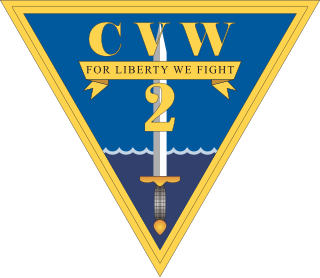
Carrier Air Wing Two (CVW-2) is a United States Navy aircraft carrier air wing based at Naval Air Station Lemoore. The air wing is attached to the aircraft carrier USS Carl Vinson (CVN-70).

Carrier Air Wing Five (CVW-5) is a United States Navy aircraft carrier air wing based at Marine Corps Air Station Iwakuni. The air wing is attached to the aircraft carrier USS Ronald Reagan. It was initially formed in 1943. It has participated in the Second World War, the Korean War, the Gulf War, Operation Southern Watch, the War in Afghanistan, and the War in Iraq.

Carrier Air Wing Fourteen (CVW-14), was a United States Navy aircraft carrier air wing based at Naval Air Station Lemoore, California.

Carrier Air Wing Seventeen (CVW-17), is a United States Navy aircraft carrier air wing based at Naval Air Station Lemoore, California. The air wing is attached to the aircraft carrier USS Nimitz.
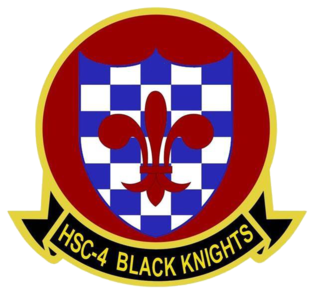
Helicopter Sea Combat Squadron Four (HSC-4), also known as the Black Knights, is a multi-role combat helicopter squadron of the United States Navy based at Naval Air Station North Island which operates Sikorsky MH-60S Seahawk helicopters deployed aboard aircraft carriers. The squadron was originally established as HS-4 on 30 June 1952 at U.S. Naval Auxiliary Landing Field Imperial Beach with the Sikorsky HO3S-1 and was redesignated HSC-4 on 29 March 2012. It is currently assigned to Carrier Air Wing Two (CVW-2) which deploys aboard USS Carl Vinson (CVN-70).

Helicopter Anti-Submarine Squadron 9 (HS-9) was the designation of two helicopter antisubmarine warfare squadrons of the United States Navy. The first squadron bearing the designation HS-9 was established on 1 June 1956 at Naval Air Station Quonset Point, Rhode Island with five HSS-1N “Seabat” helicopters. The squadron was disestablished on 1 October 1968. Eight years later, a new squadron was established on 4 June 1976; it was also designated HS-9. It deployed eight Sikorsky SH-3H “Sea Kings”. That squadron was disestablished on 30 April 1993.

Helicopter Sea Combat Squadron SIX (HSC-6), is a helicopter squadron of the United States Navy. It was established as Helicopter Antisubmarine Squadron SIX (HS-6) on 1 June 1956. Its nickname is Screamin’ Indians. On 8 July 2011 it was redesignated Helicopter Sea Combat Squadron SIX (HSC-6). It is based at Naval Air Station North Island, is part of Carrier Air Wing 17 and deploys aboard the aircraft carrier USS Nimitz (CVN-68).

Helicopter Sea Combat Squadron 12 (HSC-12)Golden Falcons is a United States Navy helicopter squadron formerly designated HS-2, based at Naval Air Facility Atsugi, in Japan. They are attached to Carrier Air Wing Five with the aircraft carrier USS Ronald Reagan.
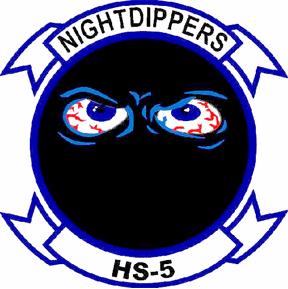
Helicopter Sea Combat Squadron FIVE (HSC-5), also known as the Nightdippers, is a helicopter squadron of the United States Navy based at Naval Station Norfolk operating the Sikorsky MH-60S Seahawk. The Nightdippers are a part of Carrier Air Wing Seven and deploy aboard USS George H. W. Bush (CVN-77) to provide anti-surface warfare, search and rescue, vertical replenishment, Combat Search and Rescue and Naval Special Warfare Support capabilities to the carrier strike group.
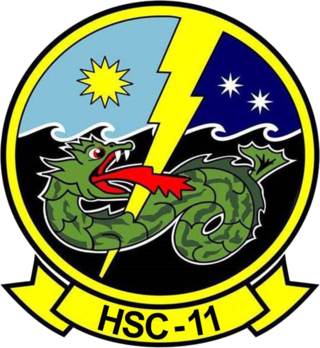
Helicopter Sea Combat Squadron 11 (HSC-11), also known as the Dragonslayers, is a United States Navy helicopter squadron based at Naval Air Station Norfolk as part of Carrier Air Wing 1 operating MH-60S helicopters deployed aboard aircraft carriers. The squadron was established on 27 June 1957 at Naval Air Station Quonset Point as Helicopter Anti-Submarine Squadron 11 (HS-11) with Sikorsky HSS-1 Seabat helicopters. In 2016, HS-11 transitioned to MH-60S and re-designated as HSC-11.

Helicopter Sea Combat Squadron 14 (HSC-14) "Chargers" is an aviation unit of the United States Navy based at Naval Air Station North Island, California (USA). HSC-14 was established as Helicopter Anti-Submarine Squadron 14 (HS-14) in 1984 and was redesignated HSC-14 in 2013. The squadron is equipped with the Sikorsky MH-60S Seahawk.
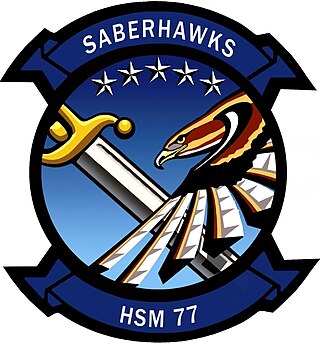
Helicopter Maritime Strike Squadron Seven Seven (HSM-77) "Saberhawks" is a United States Navy helicopter squadron based at Naval Air Facility, Atsugi, Japan. HSM-77 is attached to Carrier Air Wing Five and deploys aboard USS Ronald Reagan and air capable ships attached to Carrier Strike Group Five (CSG-5). The squadron was established as Helicopter Antisubmarine Squadron (Light) Forty Seven (HSL-47) on 25 September 1987 and was redesignated HSM-77 on 2 Apr 2009.

Helicopter Sea Combat Squadron 9 (HSC-9) "Tridents" is a United States Navy helicopter squadron based at Naval Air Station Norfolk, Norfolk, Virginia. The squadron is equipped with the Sikorsky MH-60S Seahawk. Currently, HSC-9 is attached to Carrier Air Wing Eight. It was originally established as Helicopter Anti-Submarine Squadron 3 (HS-3) in 1952 and was redesignated on 1 June 2009.

Sea Control Squadron 37 or VS-37 also known as the "Sawbucks" was an Anti Submarine Warfare squadron that was decommissioned in 1995 along with CVW-15. During its active history, it flew during the Korean and Vietnam Wars as well as operating the last S-2 Trackers inservice with the US Navy in 1975.

Sea Control Squadron 38 or VS-38, nicknamed the "Red Griffins" was a former United States Navy Anti-Submarine Warfare and later Sea-Control squadron between 1950 and 2004. During its service life, they took part in the Korean War, Vietnam War, the 1991 Gulf War and the 2003 Invasion of Iraq.




















